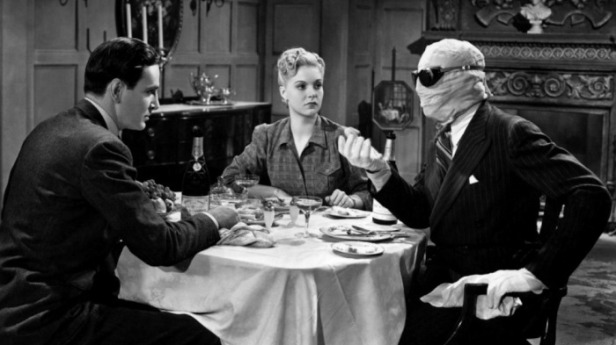The title of Joe May’s first sequel to James Whale’s The Invisible Man (1933) is something of a misnomer. Whales’s film had been a huge hit and when Universal resumed production of their genre films with Son of Frankenstein (1939) after a short hiatus, a sequel seemed like a good way to go. But the eponymous invisible man, Jack Griffin, wasn’t like the other members of Universal’s monster menagerie – he was human, with no supernatural powers of regeneration and he’d very definitively died at the climax of the 1933 film. So, for this follow-up, writers Lester K. Cole and Curt Siodmak, working from a story by May, Siodmak and Cedric Belfrage had to come up with an entirely new invisible man who wasn’t returning from anywhere.
Said invisible man is Sir Geoffrey Radcliffe (an early role for Vincent Price, here making his horror film debut, whose silky voice was perfect for a part in which his face would only be seen for a few minutes at the end of the film), sentenced to hang for the murder of his brother Michael, a crime he didn’t commit. Salvation comes in the unlikely guise of Dr Frank Griffin (John Sutton), Jack’s brother, who has taken over development of the invisibility drug, now upgraded from Monocane to Duocane (presumably to avoid any more confusion with the real drug monocaine). He injects Radcliffe with the serum, allowing to bust out of jail and start tracking down the real killer, with Scotland Yard’s Detective Sampson (Cecil Kellaway) and his gaggle of typically useless Universal coppers (“I’ll have to see ‘im before I believe he’s invisible”) on his trail. But time is short as the effects of Duocane will drive him mad, as it did Griffin. He finds the culprit close to home when he learns that the family mining business has been put in the hands of unqualified new employee Willie Spears (Alan Napier, later Alfred in TV’s Batman (1966-1968)) who is tortured into revealing that Richard Cobb (Sir Cedric Hardwicke), Radcliffe’s cousin, is the murderer. The stage is set for a spectacular showdown in the workings of a mine head.

Though The Invisible Man had had its fair share of gallows humour (it was a James Whale film after all), The Invisible Man Returns is even jokier, the mood here generally lighter all round, with less of the Gothic atmosphere to go with the gags, though it is at times a little risqué – there’s a ribald exchange relating to Radcliffe’s nudity and his fainting girlfriend Helen (Nan Grey). Which is not to film’s detriment at all. It’s more of a mystery thriller than the first film, with a dash of the procedural as Radcliffe pieces together the clues and tracks down the killer. Indeed the film soon becomes less about Radcliffe’s invisibility and the madness that brings with it, than it does about his desire for revenge. The film takes a turn for the macabre in the protracted – too protracted really – tormenting of Spears, the cruelty of which cleverly and economically hints at the encroaching madness overcoming Radcliffe. This is amplified by a terrific little scene at the dinner table where Helen and Griffin listen with mounting unease as Radcliffe begins to rant in that megalomaniacal way we’d seen with the earlier Griffin.
At times, the pacing can be slightly lead-footed – that harassing of Spears needed a damn good trimming – and May’s direction is overshadowed by the genius of John P. Fulton’s remarkable effects. The Academy of Motion Picture Sciences hadn’t introduced its Best Special Effects Oscar in time for the original film (it debuted in 1938) but they made no bones about nominating Fulton for his outstanding work here, and he probably would have won had it not been for the visual spectacular that was The Thief of Bagdad which ended up taking the Oscar for that year. You can see the advances that Fulton and his team had made in the years since the original film, particularly in a still very impressive shot of the invisible Radcliffe suddenly appearing in the smoke being sprayed by the police to expose him. And there’s some lovely work in a scene where the seemingly dying Radcliffe talks to a scarecrow as he “steals” his clothes. Only seemingly dying as this time there’s a happy ending and the effects of the Duocane are reversed by Griffin leading to another extraordinary effects shot, Radcliffe slowly “rematerializing”, his veins appearing first before the rest of him coalesces and we finally to get to see the youthful Price.

The Invisible Man Returns is a modest film, very different in tone and intent to the original, but an enjoyable one, nonetheless. Performances are good all round, the script is witty and sometimes even quite clever, and those effects are still wonderful. We’ll draw a discreet veil over the collection of horrible regional British accents that make the location of the story hard to pinpoint – it would take Hollywood a few more years yet to understand that British people didn’t immediately become faux cockneys the very second they donned a policeman’s uniform… It was a hit with the public, more than making back its meagre B-movie budget and inspired Universal to make several more invisibility films – The Invisible Woman (1940), Invisible Agent (1942), The Invisible Man‘s Revenge (1944) and Abbott and Costello Meet The Invisible Man (1951). It was unofficially remade in Mexico as El hombre que logró ser invisible (1958).